Effect of Edge-Oxidized Graphene Oxide (EOGO) on Fly Ash Geopolymer
Abstract
1. Introduction
2. Materials and Specimen Preparation
2.1. Materials
2.2. Mixture Design and Specimen Preparation
3. Test Method
3.1. Compressive Strength Test
3.2. Free-Free Resonance Column Test
3.3. Density and Void Contents
3.4. Water Absorption Test
3.5. Setting Time Test
4. Results and Discussion
4.1. Compressive Strength Test
4.2. Free-Free Resonance Column Test
4.3. Density and Void Content
4.4. Water Absorption Test
4.5. Setting Time
5. Discussion
6. Conclusions
- Through compressive strength and FFRC tests, it was found that heat curing led to a higher strength and elastic modulus than room curing in all cases. The testing results show that 0.1% EOGO exhibited the maximum strength and modulus. Under 28-day curing, 0.1% EOGO under room curing showed 42% higher strength and 26% higher elastic modulus than the control (no EOGO). On the other hand, 28-day heat curing showed a 17% increase for both strength and modulus.
- It was expected that when EOGO was added to the fly ash geopolymer, the nano-sized EOGO would fill the pores of the geopolymer, and the effect would be best observed at 0.1% EOGO. However, 0.5% and 1% EOGO showed a lower density and higher void contents compared to 0.1% EOGO. This is probably due to the agglomeration of EOGO.
- Due to the pores and high surface area of EOGO, 0.5% and 1% EOGO showed higher water absorption and a decreased setting time. Because EOGO filled the pores, but agglomeration occurred with a higher amount of EOGO, more pores were created and water was absorbed through these pores. And the setting time was decreased because the high surface area of EOGO reduced the free water.
Author Contributions
Funding
Institutional Review Board Statement
Informed Consent Statement
Data Availability Statement
Conflicts of Interest
References
- Gidebo, F.A.; Yasuhara, H.; Kinoshita, N. Stabilization of expansive soil with agricultural waste additives: A review. Int. J. Geo-Eng. 2023, 14, 14. [Google Scholar] [CrossRef]
- Zivari, A.; Siavoshnia, M.; Rezaei, H. Effect of lime-rice husk ash on geotechnical properties of loess soil in Golestan province, Iran. Int. J. Geo-Eng. 2023, 14, 20. [Google Scholar] [CrossRef]
- Davidovits, J. Geopolymers. J. Therm. Anal. 1991, 37, 1633–1656. [Google Scholar] [CrossRef]
- Davidovits, J. Geopolymer Chemistry and Applications; Geopolymer Institute: Saint-Quentin, France, 2008. [Google Scholar]
- Palomo, A.; Grutzeck, M.W.; Blanco, M.T. Alkali-activated fly ashes: A cement for the future. Cem. Concr. Res. 1999, 29, 1323–1329. [Google Scholar] [CrossRef]
- Sierra, K.; An, J.; Shamet, R.; Chen, J.; Kim, Y.J.; Nam, B.H.; Park, P. A review of geopolymer binder as a grouting material. Int. J. Geo-Eng. 2024, 15, 21. [Google Scholar] [CrossRef]
- Nath, P.; Sarker, P.K. Effect of GGBFS on setting, workability and early strength properties of fly ash geopolymer concrete cured in ambient condition. Constr. Build. Mater. 2014, 66, 163–171. [Google Scholar] [CrossRef]
- Nath, P.; Sarker, P.K. Use of OPC to improve setting and early strength properties of low calcium fly ash geopolymer concrete cured at room temperature. Cem. Concr. Compos. 2015, 55, 205–214. [Google Scholar] [CrossRef]
- Hardjito, D.; Rangan, B.V. Development and Properties of Low-Calcium Fly Ash-Based Geopolymer Concrete; Curtin University of Technology: Perth, Australia, 2005. [Google Scholar]
- Wallah, S.E.; Rangan, B.V. Low-Calcium Fly Ash-Based Geopolymer Concrete: LONG-Term Properties; Curtin University of Technology: Perth, Australia, 2006; Volume 108. [Google Scholar]
- Bellum, R.R.; Muniraj, K.; Indukuri, C.S.R.; Madduru, S.R.C. Investigation on performance enhancement of fly ash-GGBFS based graphene geopolymer concrete. J. Build. Eng. 2020, 32, 101659. [Google Scholar] [CrossRef]
- Al-Swaidani, A.M.; Meziab, A.; Khwies, W.T.; Al-Bali, M.; Lala, T. Building MLR, ANN and FL models to predict the strength of problematic clayey soil stabilized with a combination of nano lime and nano pozzolan of natural sources for pavement construction. Int. J. Geo-Eng. 2024, 15, 2. [Google Scholar] [CrossRef]
- Ahmadullah, T.; Chrysochoou, M. Relationship between strength development and pozzolanic reactions in lime stabilized kaolinite. Int. J. Geo-Eng. 2024, 15, 11. [Google Scholar] [CrossRef]
- Li, M.; Luo, R.; Qin, L.; Liu, H.; Duan, P.; Jing, W.; Zhang, Z.; Liu, X. High temperature properties of graphene oxide modified metakaolin based geopolymer paste. Cem. Concr. Compos. 2022, 125, 104318. [Google Scholar] [CrossRef]
- Liu, C.; Huang, X.; Wu, Y.Y.; Deng, X.; Liu, J.; Zheng, Z.; Hui, D. Review on the research progress of cement-based and geopolymer materials modified by graphene and graphene oxide. Nanotechnol. Rev. 2020, 9, 155–169. [Google Scholar] [CrossRef]
- Tao, J.; Wang, X.; Wang, Z.; Zeng, Q. Graphene nanoplatelets as an effective additive to tune the microstructures and piezoresistive properties of cement-based composites. Constr. Build. Mater. 2019, 209, 665–678. [Google Scholar] [CrossRef]
- Maglad, A.M.; Zaid, O.; Arbili, M.M.; Ascensão, G.; Șerbănoiu, A.A.; Grădinaru, C.M.; García, R.M.; Qaidi, S.M.; Althoey, F.; de Prado-Gil, J. A study on the properties of geopolymer concrete modified with nano graphene oxide. Buildings 2022, 12, 1066. [Google Scholar] [CrossRef]
- An, J.; Nam, B.H.; Alharbi, Y.; Cho, B.H.; Khawaji, M. Edge-oxidized graphene oxide (EOGO) in cement composites: Cement hydration and microstructure. Compos. Part B: Eng. 2019, 173, 106795. [Google Scholar] [CrossRef]
- An, J.; McInnis, M.; Chung, W.; Nam, B.H. Feasibility of using graphene oxide nanoflake (GONF) as additive of cement composite. Appl. Sci. 2018, 8, 419. [Google Scholar] [CrossRef]
- Cho, B.H.; Nam, B.H.; Khawaji, M. Flexural fatigue behaviors and damage evolution analysis of edge-oxidized graphene oxide (EOGO) reinforced concrete composites. Cem. Concr. Compos. 2021, 122, 104082. [Google Scholar] [CrossRef]
- Alharbi, Y.; An, J.; Cho, B.H.; Khawaji, M.; Chung, W.; Nam, B.H. Mechanical and sorptivity characteristics of edge-oxidized graphene oxide (EOGO)-cement composites: Dry-and wet-mix design methods. Nanomaterials 2018, 8, 718. [Google Scholar] [CrossRef]
- Cho, B.H.; Khawaji, M.; Nam, B.H.; Alharbi, Y.; An, J. Static and cyclic flexural behaviors of edge-oxidized graphene oxide cement composites. J. Mater. Civ. Eng. 2019, 31, 04019273. [Google Scholar] [CrossRef]
- ASTM C618-19; Standard Spedcification for Coal Fly Ash and Raw or Calcined Natural Pozzolan for Use in Concrete. ASTM International: West Conshohocken, PA, USA, 2019.
- Saafi, M.; Tang, L.; Fung, J.; Rahman, M.; Liggat, J. Enhanced properties of graphene/fly ash geopolymeric composite cement. Cem. Concr. Res. 2015, 67, 292–299. [Google Scholar] [CrossRef]
- Qureshi, T.S.; Panesar, D.K. Impact of graphene oxide and highly reduced graphene oxide on cement based composites. Constr. Build. Mater. 2019, 206, 71–83. [Google Scholar] [CrossRef]
- ASTM C109/C109M-23; Standard Test Method for Compressive Strength of Hydraulic Cement Mortars (Using 2-in. or [50-mm] Cube Specimens). ASTM International: West Conshohocken, PA, USA, 2023.
- ASTM C1754/C1754M-12; Standard Test Method for Density and Void Content of Hardened Pervious Concrete. ASTM International: West Conshohocken, PA, USA, 2012.
- ASTM C1585-20; Standard Test Method for Measurement of Rate of Absorption of Water by Hydraulic-Cement Concretes. ASTM International: West Conshohocken, PA, USA, 2020.
- ASTM C191-21; Standard Test Methods for Time of Setting of Hydraulic Cement by Vicat Needle. ASTM International: West Conshohocken, PA, USA, 2021.
- Sindhunata Van Deventer, J.S.J.; Lukey, G.C.; Xu, H. Effect of curing temperature and silicate concentration on fly-ash-based geopolymerization. Ind. Eng. Chem. Res. 2006, 45, 3559–3568. [Google Scholar] [CrossRef]
- Görhan, G.; Aslaner, R.; Şinik, O. The effect of curing on the properties of metakaolin and fly ash-based geopolymer paste. Compos. Part B Eng. 2016, 97, 329–335. [Google Scholar] [CrossRef]
- Yu, Z.; Ma, J.; Ye, G.; van Breugel, K.; Shen, X. Effect of fly ash on the pore structure of cement paste under a curing period of 3 years. Constr. Build. Mater. 2017, 144, 493–501. [Google Scholar] [CrossRef]
- Day, R.L.; Marsh, B.K. Measurement of porosity in blended cement pastes. Cem. Concr. Res. 1988, 18, 63–73. [Google Scholar] [CrossRef]
- Drabczyk, A.; Kudłacik-Kramarczyk, S.; Korniejenko, K.; Figiela, B.; Furtos, G. Review of geopolymer nanocomposites: Novel materials for sustainable development. Materials 2023, 16, 3478. [Google Scholar] [CrossRef] [PubMed]
- Adak, D.; Sarkar, M.; Mandal, S. Effect of nano-silica on strength and durability of fly ash based geopolymer mortar. Constr. Build. Mater. 2014, 70, 453–459. [Google Scholar] [CrossRef]
- Ravitheja, A.; Kumar, N.K. A study on the effect of nano clay and GGBS on the strength properties of fly ash based geopolymers. Mater. Today Proc. 2019, 19, 273–276. [Google Scholar] [CrossRef]
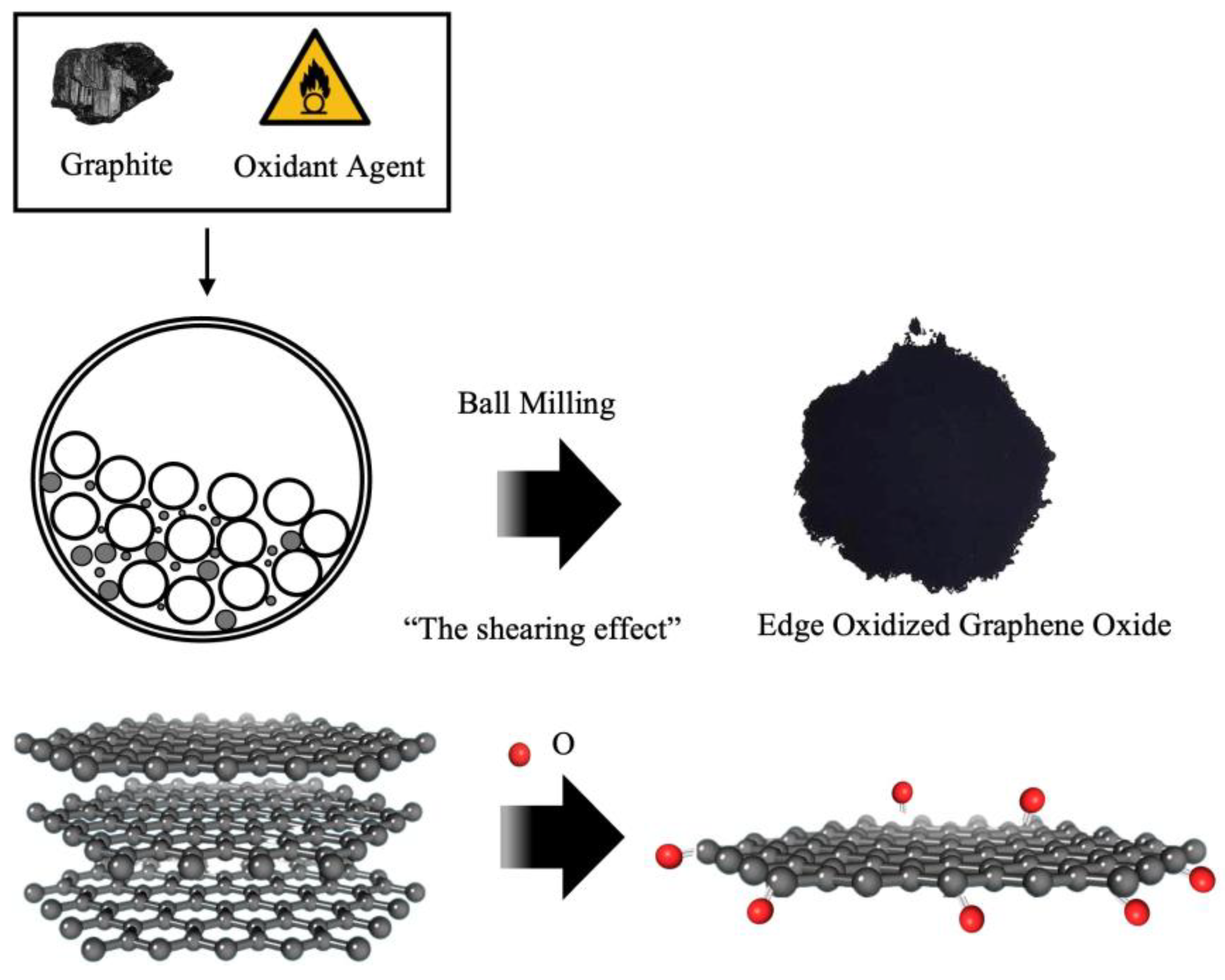
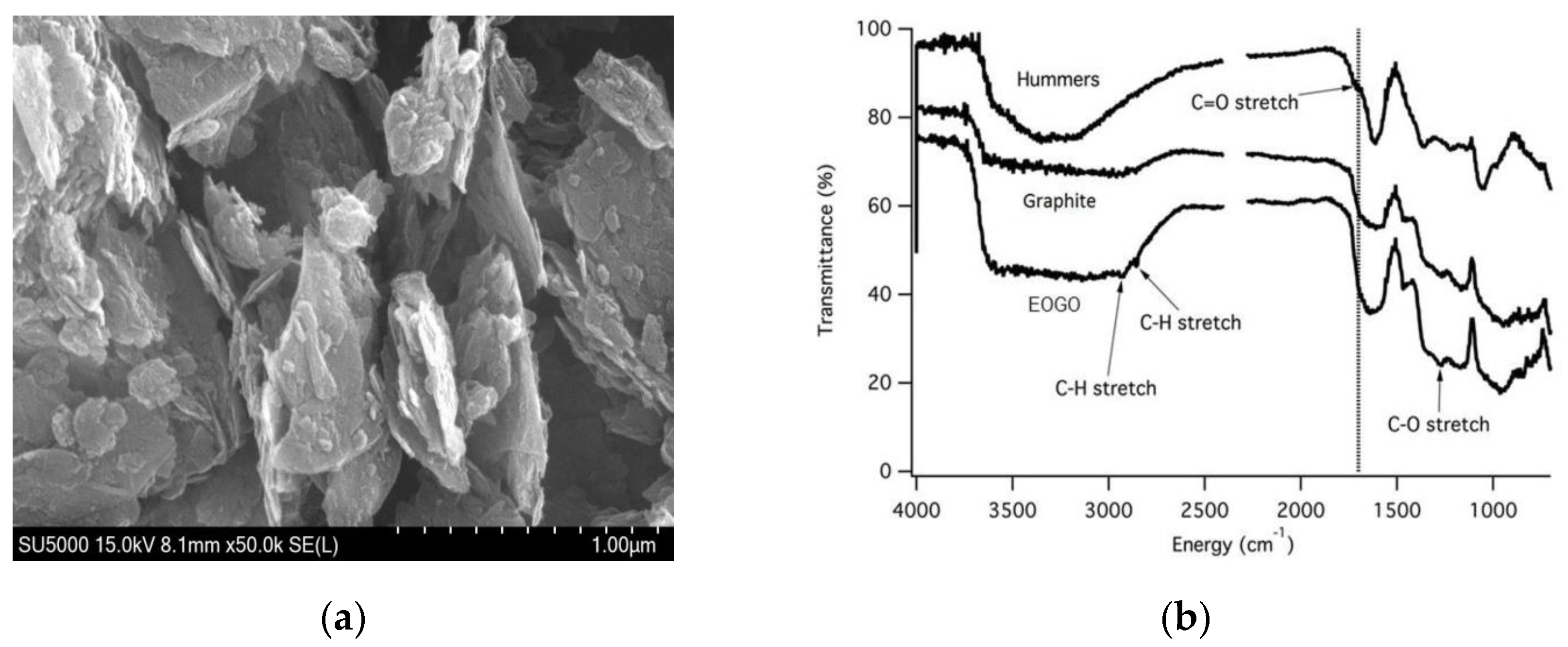
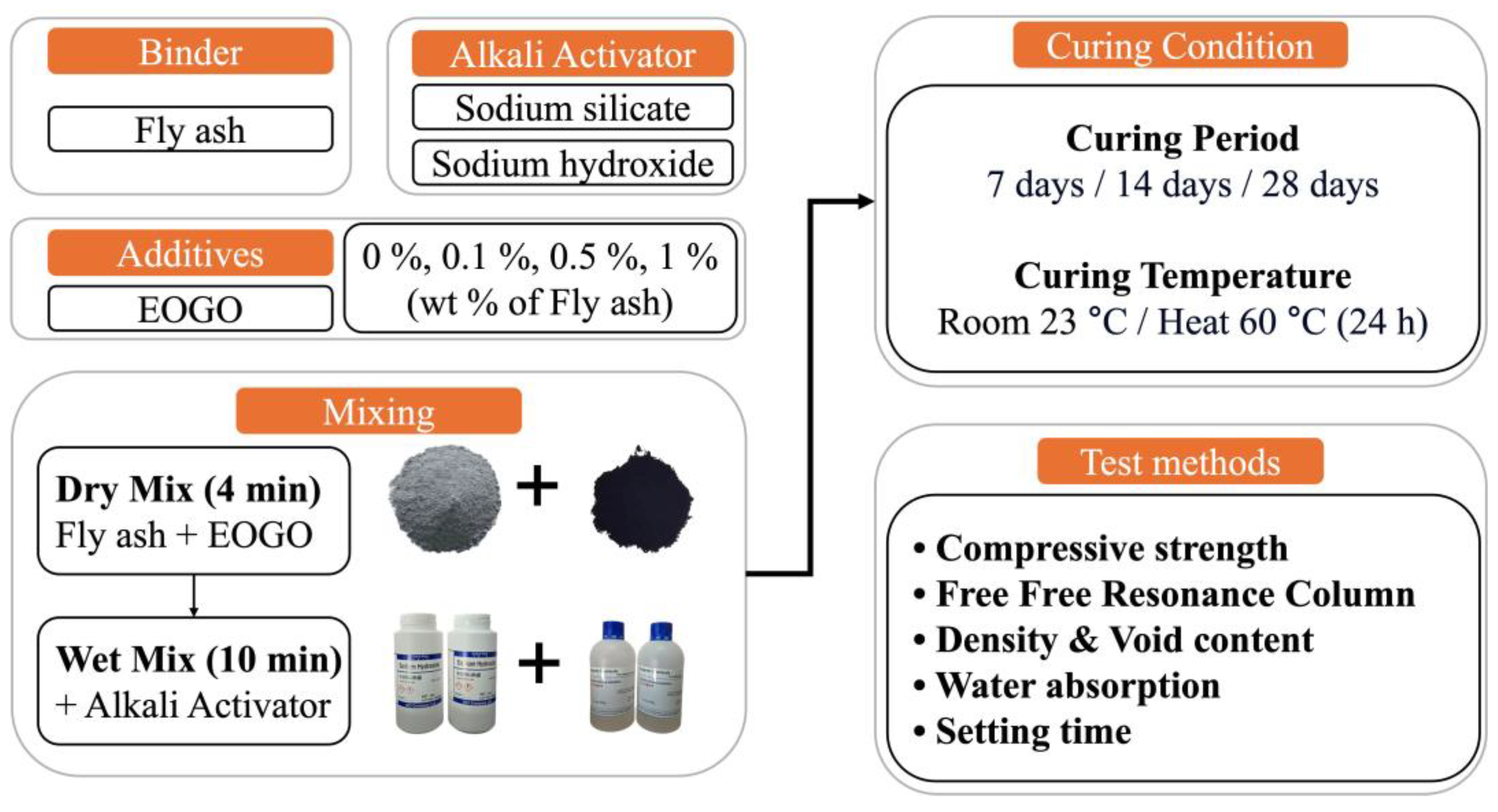
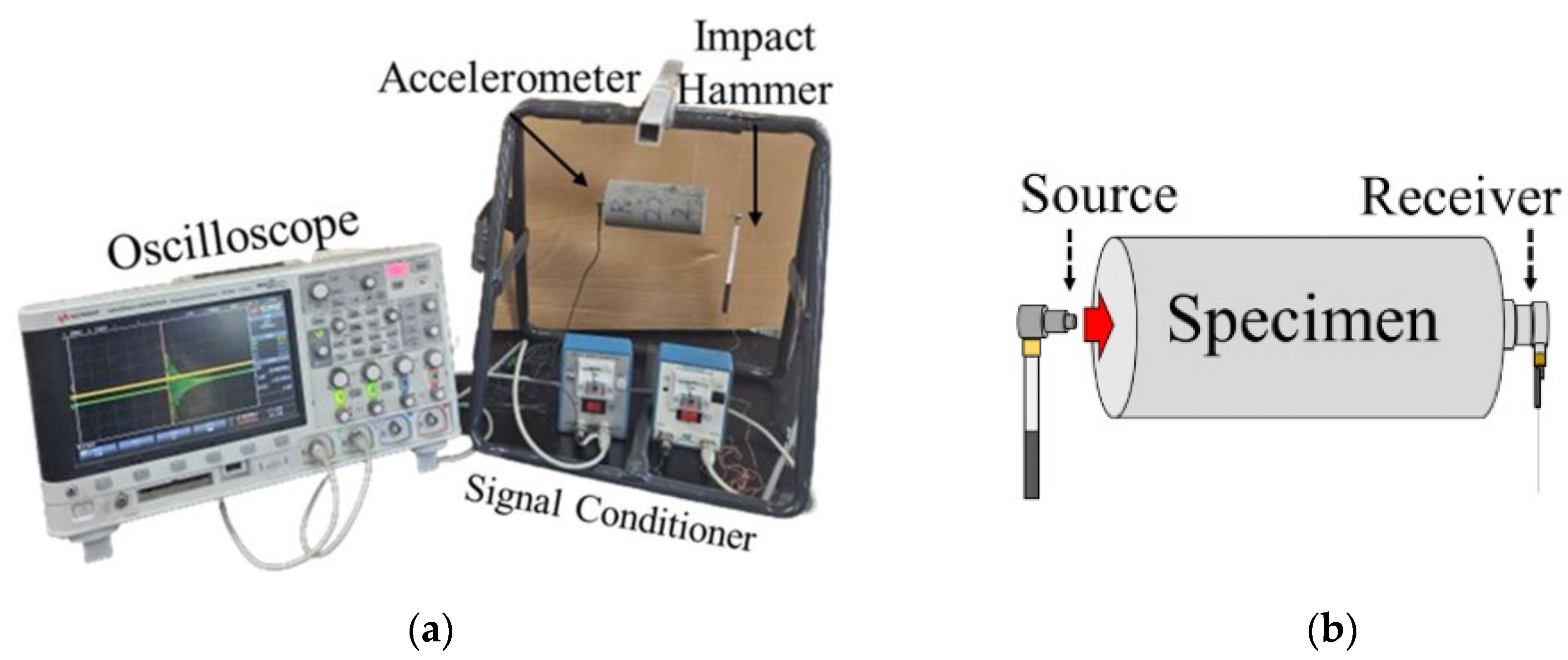

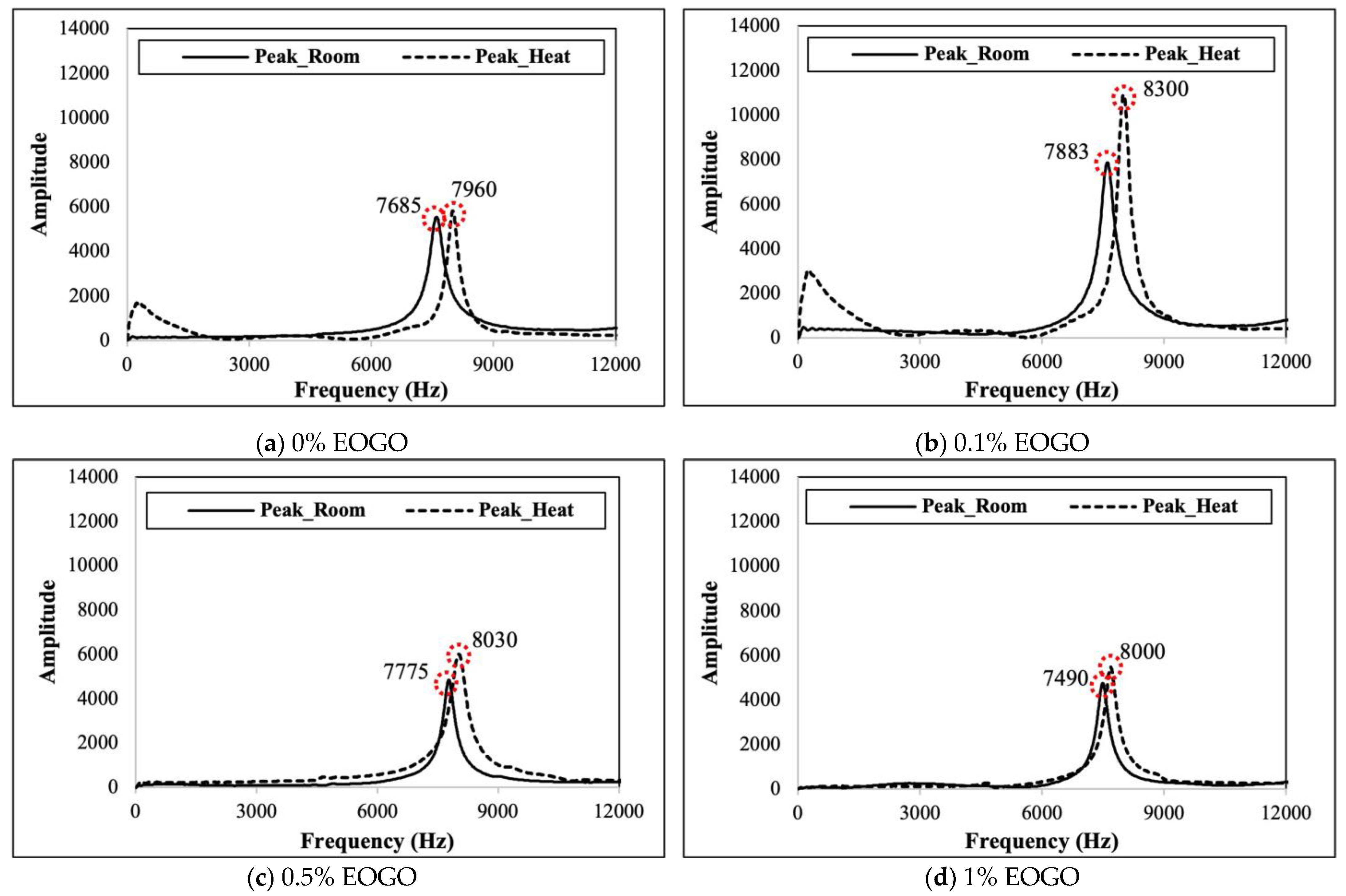

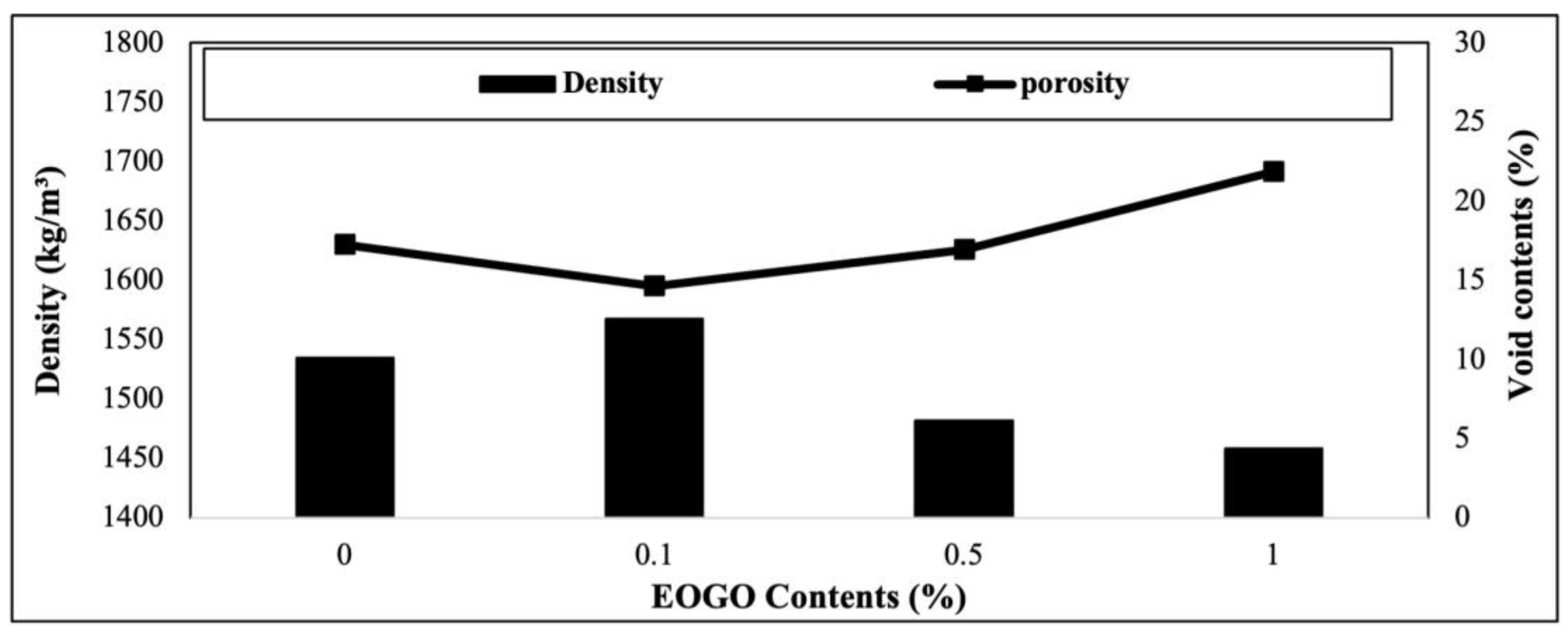



| SiO2 | Al2O3 | Fe2O3 | CaO | LOI | Balance |
|---|---|---|---|---|---|
| 57.3 | 27.15 | 8.2 | 3.7 | 2.39 | 1.26 |
| Oxygen (%) | Nonoxygen Composition | |||||
| Carbon (%) | Specific Gravity | Surface Area (m2/g) | Mean Particle Size (nm) | Thickness (nm) | Density (g/cm3) | |
| 5–10 | >99.8 | 1.91 | 200–300 | 450 | ~10 | 1.0 |
| Mix | Fly Ash (g) | Activator (g) | EOGO (g) | W/S (%) |
|---|---|---|---|---|
| FA-EOGO-0% | 1376 | 880.6 | 0 | 30 |
| FA-EOGO-0.1% | 1376 | 880.6 | 1.4 | 30 |
| FA-EOGO-0.5% | 1376 | 880.6 | 6.9 | 30 |
| FA-EOGO-1% | 1376 | 880.6 | 13.8 | 30 |
Disclaimer/Publisher’s Note: The statements, opinions and data contained in all publications are solely those of the individual author(s) and contributor(s) and not of MDPI and/or the editor(s). MDPI and/or the editor(s) disclaim responsibility for any injury to people or property resulting from any ideas, methods, instructions or products referred to in the content. |
© 2025 by the authors. Licensee MDPI, Basel, Switzerland. This article is an open access article distributed under the terms and conditions of the Creative Commons Attribution (CC BY) license (https://creativecommons.org/licenses/by/4.0/).
Share and Cite
Lee, H.; Shin, J.; Cho, B.H.; Nam, B.H. Effect of Edge-Oxidized Graphene Oxide (EOGO) on Fly Ash Geopolymer. Materials 2025, 18, 3457. https://doi.org/10.3390/ma18153457
Lee H, Shin J, Cho BH, Nam BH. Effect of Edge-Oxidized Graphene Oxide (EOGO) on Fly Ash Geopolymer. Materials. 2025; 18(15):3457. https://doi.org/10.3390/ma18153457
Chicago/Turabian StyleLee, Hoyoung, Junwoo Shin, Byoung Hooi Cho, and Boo Hyun Nam. 2025. "Effect of Edge-Oxidized Graphene Oxide (EOGO) on Fly Ash Geopolymer" Materials 18, no. 15: 3457. https://doi.org/10.3390/ma18153457
APA StyleLee, H., Shin, J., Cho, B. H., & Nam, B. H. (2025). Effect of Edge-Oxidized Graphene Oxide (EOGO) on Fly Ash Geopolymer. Materials, 18(15), 3457. https://doi.org/10.3390/ma18153457








